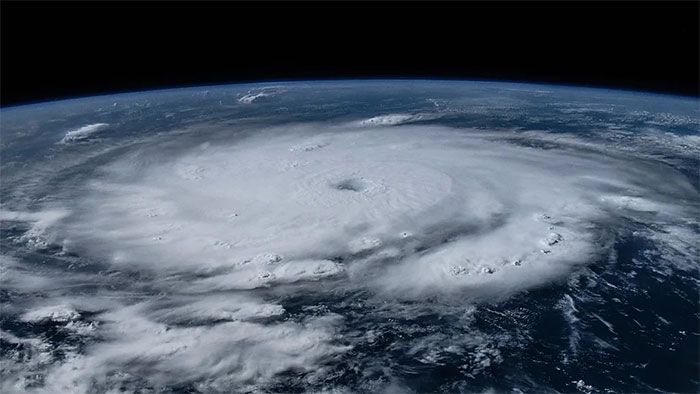Causes of increased Atlantic hurricane wind speed in 2024
On November 20, the research institute Climate Central published a study showing that human-caused warming of the ocean has increased the maximum wind speeds of every Atlantic hurricane in 2024. This reflects how climate change is amplifying the destructive power of storms.
The Climate Central study found that all 11 2024 hurricanes accelerated by 9 to 28 mph during this year's season's unprecedented ocean temperatures. The new analysis allowed the team to zero in on the path of a particular storm. For example, at the time Milton reached its peak intensity before landfall, the likelihood of climate-related sea surface warming was 100 times higher than normal, while maximum wind speeds increased by nearly 24 mph.

Hurricane Beryl was the first Category 5 storm to form in June at the start of the Atlantic hurricane season. (Photo: Nasa).
Study author Daniel Gilford said emissions of carbon dioxide (CO2) and other greenhouse gases have affected sea surface temperatures around the world. In the Gulf of Mexico, these emissions have increased sea surface temperatures by about 1.4 degrees Celsius compared to pre-climate change levels, thereby increasing the intensity of storms. Hurricanes Debby and Oscar, for example, have increased from tropical storms to hurricanes. Other storms have increased in intensity on the Saffir-Simpson scale, with Milton and Beryl rising from Category 4 to Category 5; Helene rising from Category 3 to Category 4. A one-level increase in a storm's destructive potential quadruples. Helene proved particularly devastating, claiming more than 200 lives, making it the second deadliest storm to hit the continental United States in more than half a century, after Hurricane Katrina in 2005.
Gilford and his colleagues also published another study in the journal Environmental Research Climate, which looked at hurricane intensity from 2019 to 2023. They found that 84% of hurricanes during that period had wind speeds that increased by about 18 mph (29 km/h) due to warmer ocean surface temperatures. Over those six years, warmer oceans increased the strength of 40 hurricanes, with storms increasing by one category. According to the US National Oceanic and Atmospheric Administration (NOAA), a Category 5 hurricane is 400 times more damaging than the lowest Category 1 hurricane, 140 times more damaging than the highest Category 3 hurricane, and five times more damaging than the lowest Category 4 hurricane. Three hurricanes, including this month's Hurricane Rafael, had wind speeds that increased by two categories due to climate change. What is worrying, the authors say, is not that there are more hurricanes, but that the worst storms are becoming increasingly destructive.
Although both studies focused on the Atlantic basin, the researchers say their method can be applied to tropical storms globally. The findings are more comprehensive than previous research, which has focused on the link between climate change and storm rainfall.
Climatologist Friederike Otto at Imperial College London warned that superstorms are becoming more frequent despite the world having only warmed by 1.3C since pre-industrial times. She warned that the impact could be even more severe if the temperature rise exceeds 1.5C.
- The flights across the Atlantic will be more bumpy
- What is the fastest wind speed ever recorded?
- Hurricane Milton seen from space
- New storm Kirk is getting stronger every day, how 'terrible' is it that it is predicted to be the 3rd strongest in 2024?
- Are the storms this year more devastating than previous years?
- The Atlantic Ocean will have less typhoons in 2012
- Unbelievable revelations about the terrible power of super storm Milton making landfall in the US
- Atlantic Ocean faces a big hurricane season
- First time in history: Three hurricanes at the same time in the Atlantic in October
- Super Typhoon Milton's 'pinhole eye' appears, why is it extremely dangerous?
- Why Hurricane Milton Made Meteorologists Almost Cry
- Wind speed is decreasing in the US
 Is the magnetic North Pole shift dangerous to humanity?
Is the magnetic North Pole shift dangerous to humanity? Washington legalizes the recycling of human bodies into fertilizer
Washington legalizes the recycling of human bodies into fertilizer Lightning stone - the mysterious guest
Lightning stone - the mysterious guest Stunned by the mysterious sunset, strange appearance
Stunned by the mysterious sunset, strange appearance